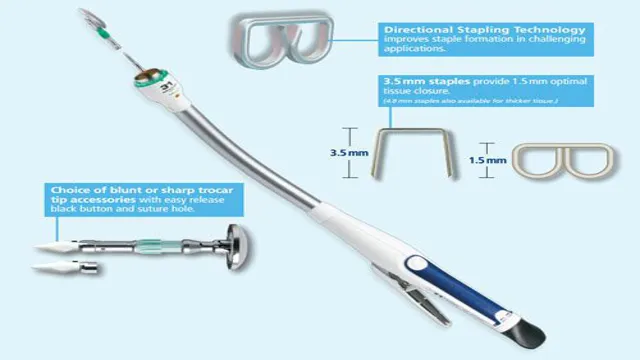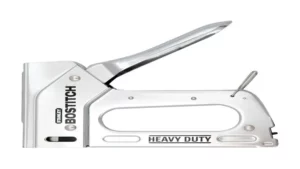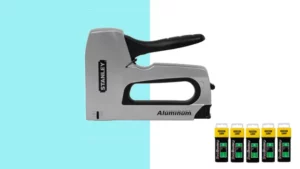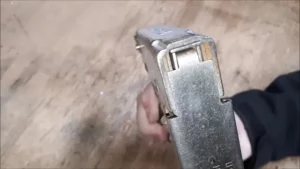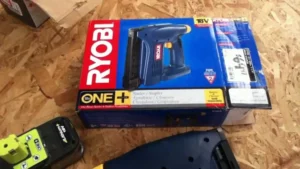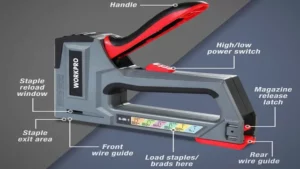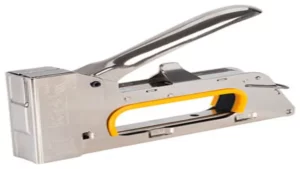When it comes to the medical industry, precision and speed are key. That’s why medical professionals have been relying on medical staple guns to get the job done. But what exactly are medical staple guns, and how do they work? In this blog post, we’ll delve into the world of medical staple guns and give you a comprehensive understanding of this valuable medical tool.
Whether you’re a medical professional or just curious about the science behind the industry, read on to learn more.
What Is a Medical Staple Gun?
A medical staple gun is a device used to close wounds or surgical incisions quickly and with minimal tissue trauma. It works by placing a line of metal staples along the edges of the wound, which hold the skin or tissue together until it heals. How does a medical staple gun work? Essentially, the staple gun is loaded with a strip of surgical staples, which are made of a biocompatible material like titanium to minimize reactions.
Once the wound has been cleaned and prepared for closure, the staple gun is positioned over the edges of the wound, and a trigger is pulled, driving the staples into the tissue and forming a secure closure. Medical staple guns come in various sizes and types, each designed for specific surgical procedures and tissues. They are widely used in hospitals and clinics, as they provide a fast, reliable, and cost-effective means of wound closure compared to traditional suturing.
Definition and Usage
A medical staple gun is a tool used in surgical procedures to close wounds or incisions instead of traditional sutures or stitches. The staple gun uses metal staples to hold the wound together. This eliminates the time-consuming process of manually sewing wounds together, reducing the risk of infection and speeding up the healing process.
The size of the staples used in medical staple guns can vary depending on the size of the wound and the location on the body. These types of staple guns are commonly used in surgeries, such as gastrointestinal procedures, skin closures, and orthopedic surgeries. One of the main advantages of using a medical staple gun is its accuracy in placing staples, which creates a consistent and precise closure, leading to less scarring and better wound healing outcomes.
Overall, medical staple guns are a valuable tool in the field of medicine used to promote faster healing times and provide patients with better outcomes.
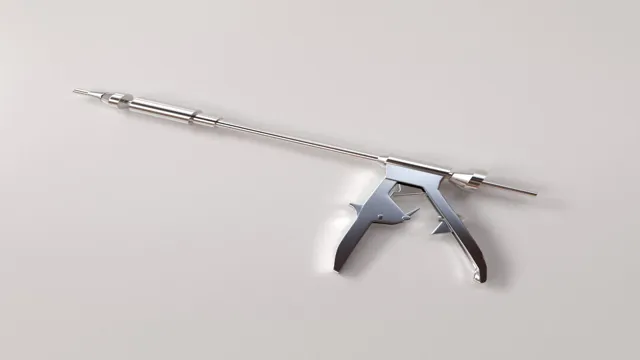
Different Types of Medical Staple Guns
A medical staple gun is a tool frequently used in surgical procedures to close incisions and wounds. These medical devices are available in various sizes and designs to suit the needs of different medical procedures. A powered stapler is one of the most common types of staple guns used in the medical field.
This device uses an electric current to activate the staple, allowing for more precise, quick, and efficient use. Another popular type of medical staple gun is the manual stapler, which operates by manually squeezing a handle to fire a staple in place. Manual staple guns are often used during surgeries where precision is critical, such as neurosurgery.
Other forms of staple guns used in the medical field include circular staplers, linear cutters, and skin staplers. Circular staplers are used in procedures that require anastomosis of the gastrointestinal or rectal area. Linear cutters, on the other hand, are used to cut tissues in a straight line, allowing for clean and precise incisions.
Finally, skin staplers are specifically designed for wound closure on the surface of the skin, making them an effective tool in emergency or trauma situations. Whether it’s for closing deep incisions or superficial wounds, medical staple guns are an essential tool in ensuring proper healing and recovery.
How Does It Work?
If you’re curious about how a medical staple gun functions, the process is pretty straightforward. Essentially, the device works by pressing two halves of a staple together, sandwiching a section of tissue or skin between them, and then simultaneously applying enough pressure to push the staple through the tissue. Once the staple has made it through the tissue, it’s crimped or bent, clamping the tissue together and creating a tight seal.
Because of its speed and versatility, a staple gun is an essential tool in many surgical procedures, especially those that involve large incisions or a lot of tissue to manipulate. While the sensation of being stapled might sound a little uncomfortable, most patients report that it’s no more painful than receiving stitches, and in many cases, the staples can be removed more quickly and easily than traditional sutures. So if you’re scheduled for surgery anytime soon, don’t be surprised if your surgeon reaches for a staple gun instead of a needle and thread!
The Mechanism of a Medical Staple Gun
Medical staple guns are commonly used in operating rooms around the world to close surgical incisions and wounds. But how do these devices work? The mechanism behind a medical staple gun is relatively simple. The gun itself consists of a housing, a trigger, a staple holder, and a spring mechanism.
When the trigger is pulled, the spring mechanism is activated, which causes a staple to be fired from the holder and into the tissue being sutured. The staples are made from medical-grade stainless steel and are designed to remain in the body without causing any harm. The size and shape of the staples vary depending on the location and type of incision being closed, but they all function in the same way.
With a medical staple gun, surgeons can quickly and efficiently close wounds, reducing the risk of infection and promoting faster healing times.
The Procedure for Using a Medical Staple Gun
A medical staple gun is a tool commonly used in surgeries to close wounds and incisions. Using a medical staple gun is a fairly straightforward procedure. First, the surgeon will insert the staple cartridge into the staple gun.
Once loaded, the surgeon will then apply the staple gun to the wound or incision and press the trigger, causing the staples to be deployed and clamp the skin together. This process is repeated until the wound is completely sealed. One advantage of using a staple gun over traditional sutures is that it saves time and effort, as it can close wounds and incisions much quicker.
However, it is important for the surgeon to be well-trained in the use of the staple gun, as improper placement or deployment of staples can result in complications and potentially harmful infections. Overall, a medical staple gun can be a useful tool in surgeries and medical procedures when used properly.
How to Reload a Medical Staple Gun
Reloading a medical staple gun may seem like a daunting task, but it’s actually quite simple. First, gather your supplies- extra staples and a fresh cartridge. Next, make sure the staple gun is turned off and carefully remove the spent cartridge.
Insert the new cartridge by aligning the grooves and sliding it in until it clicks into place. Now, load the staple gun by sliding the clip at the top towards the cartridge until it clicks into place. Pushing down on the safety will arm the staple gun, ready for use.
It’s important to follow these steps carefully, as improper reloading can lead to jams or misfires. With a little practice, reloading your medical staple gun will become second nature, allowing you to focus on providing the best care for your patients.
Advantages and Disadvantages of a Medical Staple Gun
Medical staple guns are often used in surgeries and medical procedures to close wounds and incisions. These tools operate by firing a row of staples into the skin or tissue to hold it together. The staple gun works by compressing the tissue together before firing the staples.
One of the main advantages of using a medical staple gun is that it allows for faster wound closure compared to traditional stitching methods. This can reduce the amount of time a patient spends in surgery and the risk of infection. Additionally, staple guns are less likely to cause scarring and can provide a stronger hold on the wound.
However, there are also some disadvantages to using a medical staple gun. Misfiring can occur, which can cause staples to be fired into the wrong area and result in tissue damage. Also, some patients may experience discomfort and pain during the healing process.
Overall, medical staple guns have their benefits, but proper training and careful operation are necessary to ensure safe and effective use. So, this is how a medical staple gun works in surgery and medical procedures.
Pros
Advantages and Disadvantages of a Medical Staple Gun Using a medical staple gun in surgeries can be both advantageous and disadvantageous. One of the major advantages of using a medical staple gun during surgery is that it is a faster procedure compared to traditional sutures. The staples take a shorter time to place and can cover a greater surface area than sutures can, thus saving time and reducing the length of the surgery.
Additionally, the risk of contamination associated with other surgical instruments is decreased because it does not come into contact with the tissue. Moreover, the staple gun creates a tighter, more secure seal than sutures, which is especially beneficial when sealing blood vessels or tubular structures. On the flip side, the use of a medical staple gun during surgery can be disadvantageous.
The risk of tissue damage is higher due to the pressure applied by the staple gun, which can lead to tissue necrosis or damage. Additionally, misfiring the staple gun can cause the staples to be misaligned or lodged in tissues, leading to further complications. In some cases, staples may need to be removed after surgery, which can lead to pain and discomfort for the patient.
In conclusion, while using a medical staple gun during surgery has its advantages in terms of convenience and efficiency, it is not without its risks and complications. Surgeons must weigh the pros and cons of using a staple gun and decide if it is the best option for their specific procedure and patient.
Cons
When it comes to medical procedures, speed and precision are essential. This is where a medical staple gun comes in handy, as it allows for quick and efficient closure of wounds and incisions. However, like any tool, there are advantages and disadvantages to its use.
One of the main advantages of a staple gun is its ease of use and speed of closure. It can be particularly useful in high-pressure surgical situations where speed is a priority. Additionally, it can produce less scarring than traditional sutures.
On the other hand, the use of a staple gun can lead to more tissue damage, especially if not used correctly. There is also a higher risk of infection if not properly cleaned and maintained. Therefore, it is critical to have a skilled and trained professional operate the tool in order to minimize any potential complications.
Overall, while a medical staple gun can be extremely useful in specific situations, it is important to weigh its advantages and disadvantages and carefully consider its use.
Conclusion
In conclusion, a medical staple gun may seem like a simple tool, but it operates with precision and efficiency to close wounds quickly and effectively. Just like a regular staple gun, it uses the principles of leverage and force to drive metal staples into the skin and hold it together. But unlike a DIY staple gun, it requires skill and training to use, as well as careful consideration of the patient’s unique needs.
In essence, a medical staple gun is the ultimate combination of form and function – a powerful tool in the hands of skilled medical professionals, helping to heal and mend the human body with ease.”
FAQs
What is a medical staple gun and what is it commonly used for?
A medical staple gun is a medical instrument that is used to close wounds or incisions by stapling the edges of the wound together. It is commonly used in surgical procedures and is considered a faster and simpler alternative to traditional sutures.
How is a medical staple gun used and what are the safety precautions to follow?
A medical staple gun is loaded with sterilized staples and is placed at the site of the wound. The staples are then fired into the skin, closing the edges of the wound together. Safety precautions include proper handling of the staple gun, making sure the correct staples are loaded, and avoiding areas where nerves and blood vessels are located.
What are the benefits of using a medical staple gun over traditional sutures?
The benefits of using a medical staple gun over traditional sutures include shorter procedure time, less tissue trauma, reduced risk of infection, and decreased scarring.
Can a medical staple gun be used on all types of wounds?
No, there are certain types of wounds that are not appropriate for closure with a medical staple gun. These include wounds with uneven edges, wounds with inadequate blood supply, and wounds that are contaminated.
What are the different types of medical staple guns and how do they differ?
There are several types of medical staple guns, including disposable, reusable, skin staplers, and linear staplers. They differ in terms of size, shape, and purpose.
How does a medical staple gun work and what is the mechanism behind it?
A medical staple gun works by using a spring-loaded mechanism to fire a staple through the skin. When the trigger is pulled, the staple is ejected from the gun and into the skin. The staple then bends and closes the edges of the wound together.
What are some potential complications of using a medical staple gun?
Complications of using a medical staple gun may include infection, bleeding, allergic reactions, staple failure, and damage to surrounding tissues. It is important for medical professionals to be properly trained in the use of a staple gun and to follow strict safety protocols to minimize these risks.
